Is Firefox currently losing many users?
Spoiler: Actually not. Why many browser-statistics are misleading
When I look around my circle of friends, I see many fiercely loyal Firefox users, who won’t drop Firefox as long as it works. Who put in effort to keep using it. But its market share statistics are dwindling.
Do I have to accept that my friends are outliers, or could there be a different explanation?
Update 2024: In 2022 Firefox started loosing more users. Not 50 Million per year as before 2016, but the monthly active users have been shrinking by 10-15 million per year since 2022 — from 205 million peak in 2020 to 171 million peak in 2024. 🫤
Let’s look into the data. We’ll start with the misleading statistics from Wikipedia: User share of web browsers; plotting that ourselves using the csv-data from statcounter browser-market-share:
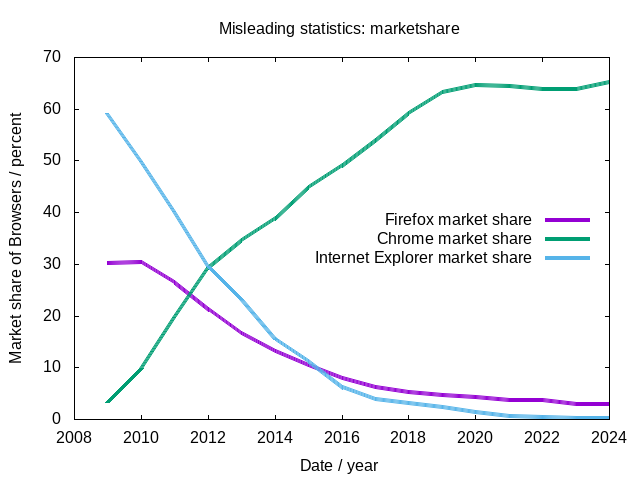
That looks pretty clear,1 and it is what almost every news site shows you. But it is relative — does it actually tell us something about user count?
We’ll need reference data: How many internet users are there? Luckily there is data on that by the ITU:
- ITU_regional_global_Key_ICT_indicator_aggregates_Nov_2023.xlsx — which fraction of the population has internet? More specifically the table “Individuals using the Internet”.
So now all we need to do is to scale the browser statistics graph with each years number of people with Internet.
First we open the ITU file with libreoffice and export it as CSV file. After selecting only “Individuals using the Internet” (the relevant part) and removing thousand-separators from numbers, this gives us millions of people. To ease reading of this article, the data is in the appendix.
Then we get the exported data from the browser statistics from statcounter browser-market-share: browser-ww-yearly-2009-2024.csv.
Now all we need to do is to merge these and plot the result with gnuplot:
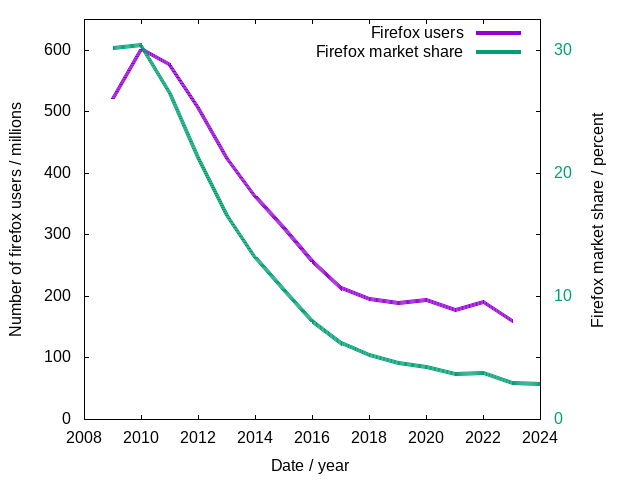
That does not look as enigmatic as before: Compared to the time when Firefox was the one browser that challenged the atrocity that was (and is) Internet Explorer, Firefox lost about two third of its users, but now its user count seems to have stabilized.
Comparing that to the Public Data Report by Mozilla shows a pretty good match: About 200 Million users, mostly stable.
So why do many browser stats look so awful?
Let’s add the numbers of internet users all over the world to the diagram (thank you, ITU!):
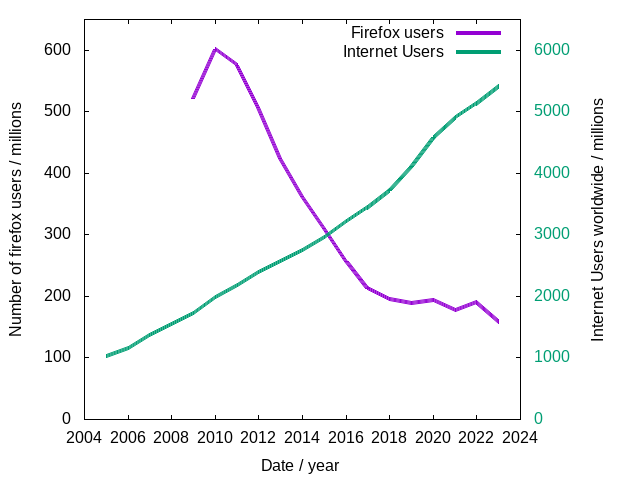
In the time since Firefox was the only alternative to IE, the number of internet users increased by factor 4. But why did Firefox not manage to get them as users?
Let’s also look at the browsers bundled with most mobile phones and tablets:
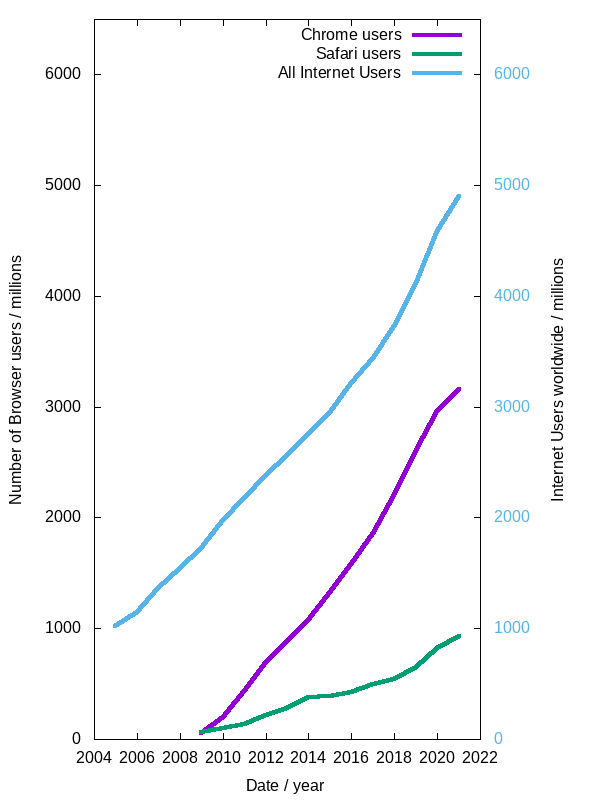
So the market share we see shows that while Firefox might not have lost as many old users as the market share would suggest, it did not manage to reach many of the new users on mobile platforms. But many Firefox users stayed Firefox users and over the past 5 years user count mostly stabilized.
When I saw that, it caused a major shift in my perception of browsers: What we’re seeing is not mainly the effect of failures by Firefox, but rather of anti-competitive bundling of browsers on mobile platforms.
Because on mobile Firefox is almost non-existent, even though it does provide decent support nowadays.
Let’s look at data one last time: browsers on mobile:
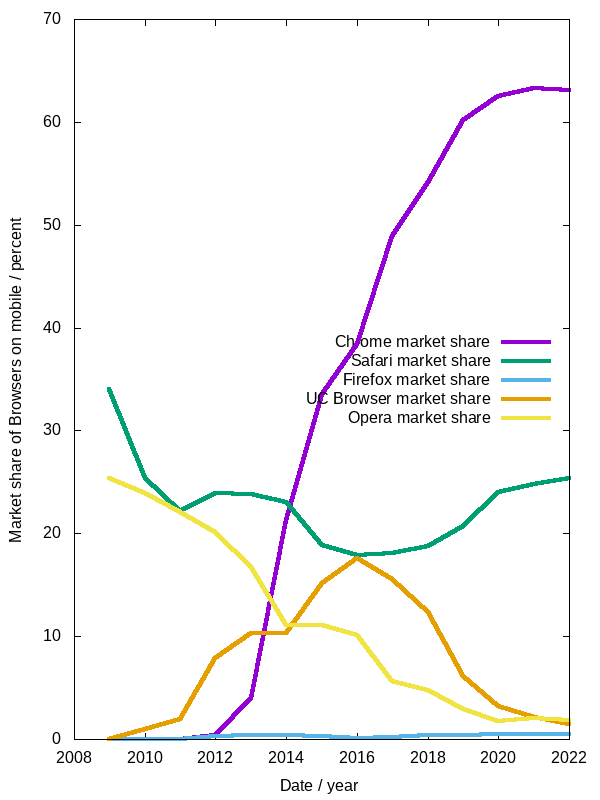
Safari and Chrome are the browsers bundled with most mobile phones. This should make it pretty clear that only the browsers bundled with the phones have decent market share while all others are losing it, even if they started strong like Opera or got some temporary foothold like UC Browser. So this is clearly a bundling issue.
The one opportunity Mozilla really missed might have been Firefox OS, abandoned in 2015 (but still in use on some TVs and lots of small phones today, see KaiOS). That would have played the bundling game, but that should not be required on open platforms. And this openness of platforms is what is missing.
In 1998, Microsoft was sued for violating antitrust laws, but could settle in 2001 to only provide its API to others, and in 2010 Microsoft was forced to offer alternative browsers in Windows in the EU, but this turned out to benefit Chrome the most.
Still, these statistics show that it is high time anti-trust actions are pulled on mobile.
And if you’re a web developer and you are tempted to drop Firefox support, then keep in mind that that might just cost you those of your users with the highest loyalty — the ones you want to lose the least, because they are the ones most likely to stick with you even if a hip, new, VC-crammed competitor comes around and tries to disrupt you.
Those 200 million users may not be the largest group of internet users, but they are 200 million, and they decided to stick to Firefox again and again in the past decade against many kinds of anti-competitive actions.
And beware of using the wrong statistical measure to take decisions: different from the market share, the Firefox user count stabilized in the past years.
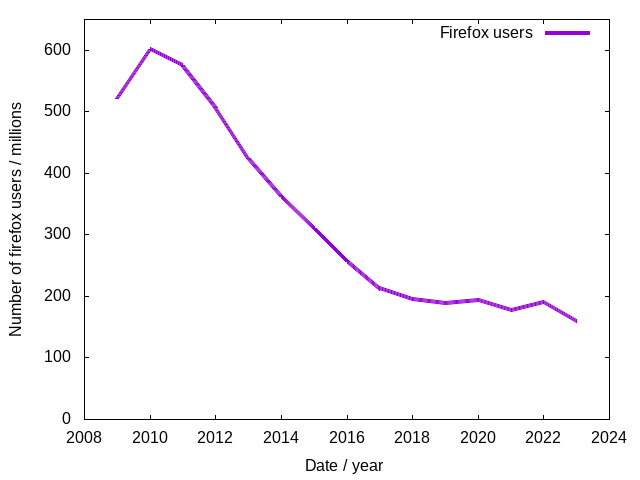
Appendix
Data: Internet users by year and region
Selecting only “Individuals using the Internet” (the relevant part) and removing thousand-separators from numbers, this gives us millions of people.
See https://www.itu.int/en/ITU-D/Statistics/Pages/stat/default.aspx — specifically: ITU_regional_global_Key_ICT_indicator_aggregates_Nov_2023.xlsx
Year,2005,2006,2007,2008,2009,2010,2011,2012,2013,2014,2015,2016,2017,2018,2019,2020,2021,2022,2023 World,1023,1147,1367,1545,1727,1981,2174,2387,2562,2750,2954,3217,3444,3729,4119,4585,4914,5132,5417 Developped,616,650,723,754,778,826,844,900,927,952,968,1026,1046,1077,1104,1123,1136,1147,1164 Developing,408,496,645,791,949,1155,1330,1487,1635,1798,1986,2192,2398,2652,3015,3521,3778,3985,4253 Least Developed Countries (LDCs),6,8,15,14,19,24,31,39,50,76,98,134,165,202,232,288,324,360,407 Land Locked Developing Countries (LLDCs),7,10,13,17,23,32,41,51,62,73,91,103,118,134,153,172,180,202,226 Small Island Developing States (SIDS),8,9,11,13,14,16,18,20,23,24,27,30,34,37,39,38,39,40,41
Low-income, Lower-middle-income, and Upper-middle-income added together, because these were all grouped as “developing” in the report from 2021.
Data: market share
Then we get the exported data from the browser statistics from statcounter browser-market-share: browser-ww-yearly-2009-2024.csv.
By StatCounter - https://gs.statcounter.com/browser-market-share#yearly-2009-2024, CC BY-SA 3.0, https://commons.wikimedia.org/w/index.php?curid=96191474
Year,Chrome,IE,Firefox,Safari,Opera,Android,UC Browser,Samsung Internet,Edge Legacy,Nokia,BlackBerry,IEMobile,Edge,NetFront,Yandex Browser,360 Safe Browser,Maxthon,QQ Browser,Sogou Explorer,Sony PS3,Chromium,Silk,Unknown,Coc Coc,Mozilla,Puffin,KaiOS,Dolfin,Sony PS4,Samsung,AOL,SeaMonkey,Openwave,Phantom,Whale Browser,SonyEricsson,Pale Moon,Obigo,Jasmine,Other 2009,3.23,59.1,30.17,3.41,2.85,0.02,0,0,0,0.19,0.08,0.01,0,0.03,0,0,0.03,0,0,0.12,0,0,0,0,0.32,0,0,0,0,0,0.2,0.03,0.02,0,0,0.01,0,0,0,0.17 2010,9.95,49.93,30.35,4.93,2.6,0.27,0.03,0,0,0.48,0.48,0.01,0,0.1,0,0,0.21,0,0,0.14,0,0,0.01,0,0.14,0,0,0,0,0.03,0.1,0.03,0.02,0,0,0.01,0,0,0,0.19 2011,19.79,40.31,26.49,6.36,3.08,1.16,0.12,0,0,0.94,0.7,0.02,0,0.21,0,0,0.14,0,0,0.14,0.04,0,0.02,0,0.04,0,0,0.04,0,0.05,0.02,0.02,0.02,0,0,0.02,0,0.04,0.03,0.19 2012,29.3,29.66,21.27,9.04,3.67,2.89,0.85,0,0,1.14,0.55,0.07,0,0.4,0,0.11,0.11,0.02,0.05,0.1,0.07,0.06,0.04,0,0.01,0,0,0.13,0,0.06,0,0.03,0.01,0.01,0,0.02,0.02,0.04,0.04,0.23 2013,34.67,23.15,16.55,10.94,3.68,5.37,1.68,0,0,1.12,0.53,0.25,0,0.39,0.22,0.21,0.16,0.05,0.13,0.09,0.06,0.14,0.08,0,0.01,0.03,0,0.08,0,0.04,0,0.02,0.02,0.03,0,0.01,0.03,0.02,0.02,0.21 2014,38.94,15.46,13.17,13.77,4,7.23,2.83,0,0,1.09,0.43,0.62,0,0.38,0.24,0.44,0.17,0.11,0.13,0.05,0.07,0.17,0.13,0.03,0.02,0.06,0,0.07,0.01,0.02,0,0.01,0.04,0.03,0,0.02,0.02,0.01,0.01,0.22 2015,44.87,11.24,10.51,13.06,5,6.31,5.37,0,0.28,0.42,0.34,0.73,0,0.15,0.28,0.18,0.15,0.16,0.13,0.02,0.09,0.12,0.09,0.07,0.02,0.05,0,0.04,0.04,0.01,0,0.02,0.02,0.03,0,0.02,0.02,0.01,0.01,0.19 2016,49.08,6.25,7.97,13.31,5.47,3.96,7.77,2.33,1.42,0.11,0.26,0.62,0,0.07,0.28,0.09,0.1,0.09,0.08,0.01,0.08,0.01,0.07,0.14,0.02,0.07,0,0.02,0.07,0,0,0.01,0.01,0.03,0,0.02,0.02,0,0,0.15 2017,53.96,3.95,6.19,14.51,3.84,2.39,8.25,3.3,1.85,0.07,0.13,0.34,0,0.02,0.27,0.05,0.06,0.12,0.07,0.01,0.07,0,0.04,0.13,0.02,0.06,0,0.01,0.09,0,0,0.01,0,0.03,0,0.01,0.01,0,0,0.14 2018,59.12,3,5.21,14.43,3.52,1.49,6.66,2.77,1.95,0.04,0.05,0.17,0,0.01,0.25,0.03,0.05,0.28,0.06,0.01,0.07,0,0.03,0.11,0.02,0.09,0.33,0,0.07,0,0,0.01,0,0.02,0.01,0.01,0.01,0,0,0.13 2019,63.31,2.24,4.57,15.86,2.57,0.86,3.3,3.45,2.14,0.01,0.02,0.08,0,0,0.25,0.02,0.04,0.25,0.06,0,0.08,0,0.02,0.12,0.04,0.13,0.35,0,0.06,0,0,0,0,0,0.07,0,0.01,0,0,0.1 2020,64.6,1.35,4.22,17.84,1.99,0.51,1.74,3.35,1.38,0,0.01,0.02,1.45,0,0.26,0.25,0.03,0.28,0.06,0,0.04,0,0.02,0.09,0.09,0.12,0.08,0,0.05,0,0,0,0,0,0.11,0,0.01,0,0,0.03 2021,64.45,0.62,3.62,18.9,2.24,0.62,1.21,3.11,0.22,0,0,0,3.59,0,0.24,0.29,0.02,0.26,0.05,0,0.02,0,0.02,0.04,0.08,0.08,0.08,0,0.04,0,0,0,0,0,0.12,0,0.01,0,0,0.02 2022,63.88,0.47,3.71,19.25,2.21,0.68,0.84,2.84,0.15,0,0,0,4.06,0,0.23,0.24,0.01,0.23,0.05,0,0.02,0,0.02,0.06,0.08,0.08,0.08,0,0.03,0,0,0,0,0,0.11,0,0.01,0,0,0.67 2023,63.87,0.21,2.95,19.78,2.74,0.62,0.89,2.48,5.03,0.05,0,0,0.01,0.26,0,0.26,0.24,0.01,0.03,0,0.16,0.01,0.01,0,0.07,0.05,0.07,0,0.02,0,0.1,0,0,0,0,0,0.04,0,0,0,0.03 2024,65.19,0.16,2.88,18.36,2.37,0.52,0.94,2.6,5.21,0.03,0,0,0,0.36,0,0.39,0.44,0,0.04,0,0.12,0.01,0.02,0,0.04,0.02,0.07,0,0.01,0,0.12,0,0,0,0,0,0.04,0,0,0,0.04
Browsers on mobile
By StatCounter - https://gs.statcounter.com/browser-market-share#yearly-2009-2024, CC BY-SA 3.0, https://commons.wikimedia.org/w/index.php?curid=96191474
Year,Chrome,Safari,UC Browser,Android,Opera,Samsung Internet,Nokia,BlackBerry,IEMobile,NetFront,Firefox,QQ Browser,Unknown,KaiOS,Dolfin,Puffin,Samsung,Edge Legacy,Yandex Browser,Openwave,SonyEricsson,Obigo,Jasmine,Whale Browser,Instabridge,Sony PSP,Tizen,Phantom,Baidu Browser,Sony PSP Vita,MeeGo,mCent,Nintendo 3DS,Bolt,Other 2009,0,34.03,0,2.46,25.33,0,18.96,8.08,0.94,2.78,0,0,0,0,0,0,0,0.49,0,1.71,0,1.38,0,0,0,0,2.24,0,0,0,0,0,0,0,0,0,1.61 2010,0,25.37,0.95,9.09,23.9,0,16.24,16.23,0.22,3.51,0,0,0,0,0,0,0,1.04,0,0.68,0,0.36,0,0,0,0,0.7,0,0,0,0,0,0,0,0,0.46,1.25 2011,0,22.18,1.9,18.11,22.1,0,15.4,11.44,0.36,3.41,0.02,0,0.33,0,0.68,0,0,0.84,0,0.37,0,0.38,0.62,0,0.57,0,0.28,0,0,0,0,0,0,0,0.01,0.31,0.7 2012,0.35,23.9,7.88,23.95,20.11,0,10.58,4.83,0.66,3.64,0.33,0.03,0.41,0,1.17,0,0,0.6,0,0.12,0,0.14,0.33,0,0.37,0,0.16,0,0.04,0,0,0,0.03,0,0.14,0,0.23 2013,3.98,23.8,10.31,28.68,16.75,0,6.9,3.06,1.54,2.41,0.35,0.05,0.42,0,0.52,0.1,0,0.26,0,0.15,0,0.06,0.11,0,0.12,0,0.07,0,0.1,0,0,0,0.02,0,0.08,0,0.14 2014,21.25,23.03,10.31,23.1,11.06,0,4.03,1.52,2.29,1.41,0.41,0.1,0.46,0,0.25,0.12,0.02,0.07,0,0.13,0,0.08,0.05,0,0.05,0,0.01,0,0.06,0,0.04,0.05,0.01,0,0.02,0,0.08 2015,33.58,18.84,15.12,15.39,11.04,0,1.2,0.93,2.08,0.42,0.3,0.2,0.25,0,0.1,0.09,0.04,0.02,0.01,0.05,0,0.05,0.02,0,0.01,0,0,0.04,0.03,0,0.07,0.04,0.03,0,0.01,0,0.03 2016,38.38,17.92,17.56,7.33,10.15,5.36,0.25,0.59,1.42,0.17,0.08,0.09,0.16,0,0.04,0.1,0.05,0.01,0.11,0.02,0,0.04,0.01,0,0.01,0,0,0.03,0.01,0,0.03,0.02,0.04,0,0,0,0.01 2017,48.86,18.08,15.56,3.49,5.61,6.42,0.13,0.24,0.65,0.04,0.21,0.12,0.08,0,0.02,0.08,0.08,0,0.14,0.01,0,0.02,0,0,0,0,0,0.09,0.01,0,0.02,0.01,0.02,0,0,0,0 2018,54.17,18.77,12.31,1.98,4.78,5.46,0.08,0.09,0.33,0.02,0.43,0.36,0.06,0.64,0.01,0.14,0.1,0,0.1,0,0,0.01,0,0,0,0,0,0.03,0.01,0,0.01,0.01,0.01,0.08,0,0,0 2019,60.14,20.75,6.17,0.98,2.88,6.86,0.03,0.03,0.15,0.01,0.36,0.33,0.04,0.69,0,0.23,0.1,0,0.05,0,0.09,0,0,0,0,0,0,0,0,0,0,0.01,0,0.08,0,0,0 2020,62.5,24.05,3.21,0.36,1.71,6.49,0,0.01,0.04,0,0.45,0.39,0.04,0.15,0,0.22,0.12,0,0.09,0,0.13,0,0,0,0,0,0,0,0,0.01,0,0,0,0,0,0,0 2021,63.3,24.77,2.13,0.54,2,5.67,0,0.01,0.01,0,0.5,0.32,0.03,0.15,0,0.14,0.14,0,0.1,0,0.15,0,0,0,0,0.03,0,0,0,0.01,0,0,0,0,0,0,0.01 2022,64.39,24.76,1.44,0.72,1.77,4.86,0,0,0.01,0,0.49,0.27,0.04,0.1,0,0.14,0.12,0,0.01,0,0.13,0,0,0.56,0,0.13,0,0,0,0.05,0,0,0,0,0,0,0.01 2023,64.12,25.42,1.6,0.66,1.91,4.51,0,0,0.01,0,0.5,0.25,0.02,0.13,0,0.08,0.18,0,0.01,0,0.14,0,0,0.06,0,0.19,0,0,0,0.16,0,0,0,0,0,0,0.02 2024,65.93,23.68,1.54,0.38,2.08,4.31,0,0,0.01,0,0.52,0.45,0.03,0.12,0,0.03,0.21,0,0.01,0,0.15,0,0,0.06,0,0.36,0,0,0,0.11,0,0,0,0,0,0,0.04
Processing: Aggregation
Multiply market share with the number of internet users in the same year.
import : dsv ;; using https://github.com/artyom-poptsov/guile-dsv only (srfi :26) cut ;; allows for simpler mapping ;; browser market share has swapped axes; me must undo that define : swap-axes table map : λ (n) : map (cut list-ref <> n) table iota : length : car table ;; read the the data define : read-csv filename dsv->scm : open-input-file filename . #\, ;; delimiter: , define individuals-with-internet-table read-csv "itu-individuals-using-the-internet.csv" define browser-market-share swap-axes read-csv "browser-ww-yearly-2009-2024.csv" ;; select the data define : select-row name table map string->number and=> (assoc name table) cdr ;; internet users define iwi-years : select-row "Year" individuals-with-internet-table define iwi-world : select-row "World" individuals-with-internet-table ;; map from year to number of internet users define iwi-year->world : map cons iwi-years iwi-world ;; browser market share data we’ll need define bms-years : select-row "Year" browser-market-share define bms-firefox : select-row "Firefox" browser-market-share define bms-chrome : select-row "Chrome" browser-market-share define bms-safari : select-row "Safari" browser-market-share define : scale-by-total-internetusers year percentage and=> (assoc year iwi-year->world) λ (multiplier) list : number->string year number->string : * percentage (cdr multiplier) 0.01 define : marketshare->usercount marketshare filter : λ (x) x map scale-by-total-internetusers . bms-years marketshare ;; combine the data define firefox-usercount marketshare->usercount bms-firefox define safari-usercount marketshare->usercount bms-safari define chrome-usercount marketshare->usercount bms-chrome ;; also output the world internet usercount for comparison define population-worldinternet map λ (year-to-population) map number->string list (car year-to-population) (cdr year-to-population) . iwi-year->world ;; output the data scm->dsv firefox-usercount (open-output-file "firefox-usercount-world.csv") #\space scm->dsv chrome-usercount (open-output-file "chrome-usercount-world.csv") #\space scm->dsv safari-usercount (open-output-file "safari-usercount-world.csv") #\space display "Firefox Users\n" scm->dsv firefox-usercount (current-output-port) #\space display "\nChrome Users\n" scm->dsv chrome-usercount (current-output-port) #\space display "\nSafari Users\n" scm->dsv safari-usercount (current-output-port) #\space scm->dsv population-worldinternet (open-output-file "all-usercount-world.csv") #\space display "\nInternet Users\n" scm->dsv population-worldinternet (current-output-port) #\space
Firefox Users 2009 521.0359000000001 2010 601.2335 2011 575.8926 2012 507.7149 2013 424.01099999999997 2014 362.175 2015 310.4654 2016 256.3949 2017 213.1836 2018 194.2809 2019 188.2383 2020 193.48699999999997 2021 177.4162 Chrome Users 2009 55.7821 2010 197.10949999999997 2011 430.2346 2012 699.3910000000001 2013 888.2454000000001 2014 1070.85 2015 1325.4597999999999 2016 1578.9035999999999 2017 1858.3824 2018 2204.5848 2019 2607.7389000000003 2020 2961.91 2021 3158.6945 Safari Users 2009 58.89070000000001 2010 97.6633 2011 138.2664 2012 215.7848 2013 280.2828 2014 378.675 2015 385.7924 2016 428.18270000000007 2017 499.72440000000006 2018 538.0947 2019 653.2733999999999 2020 817.9639999999999 2021 926.289 Internet Users 2005 1023 2006 1147 2007 1367 2008 1545 2009 1727 2010 1981 2011 2174 2012 2387 2013 2562 2014 2750 2015 2954 2016 3217 2017 3444 2018 3729 2019 4119 2020 4585 2021 4901
Footnotes:
Keep in mind that this data is imperfect. It gives an indication of the market share and its changes, but it is not the one truth. As comparison: Netmarketshare gives a browser share of 1.77 to 3.62 % throughout 2021 while statcounter only gives 3.62%. A ground truth we have is the Public Data Report by Mozilla which shows 200 Million users — in line with statcounter but not so much with netmarketshare.
